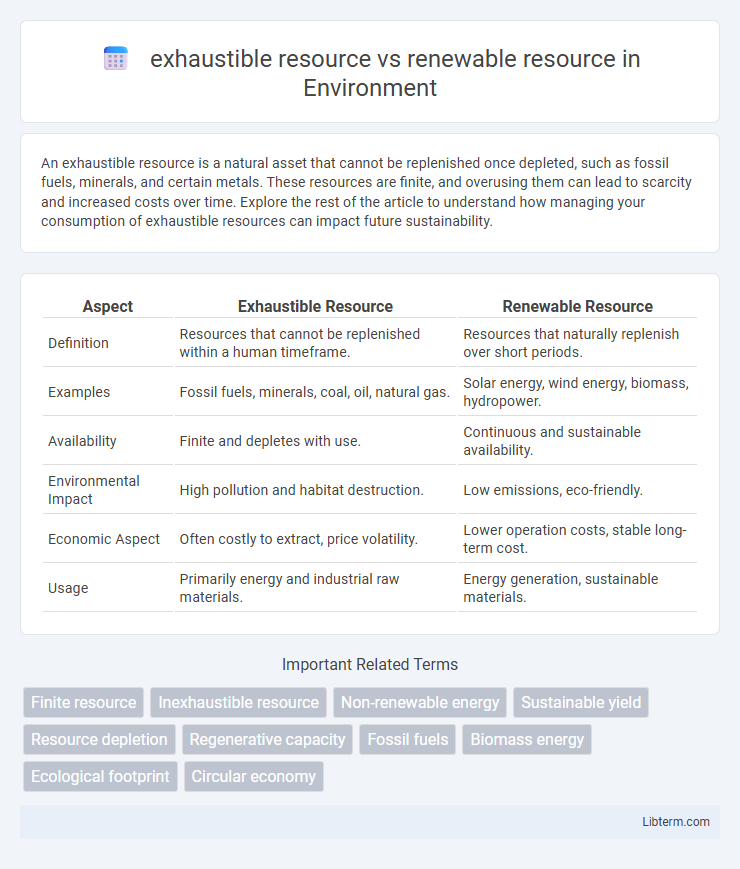An exhaustible resource is a natural asset that cannot be replenished once depleted, such as fossil fuels, minerals, and certain metals. These resources are finite, and overusing them can lead to scarcity and increased costs over time. Explore the rest of the article to understand how managing your consumption of exhaustible resources can impact future sustainability.
Table of Comparison
| Aspect | Exhaustible Resource | Renewable Resource |
|---|---|---|
| Definition | Resources that cannot be replenished within a human timeframe. | Resources that naturally replenish over short periods. |
| Examples | Fossil fuels, minerals, coal, oil, natural gas. | Solar energy, wind energy, biomass, hydropower. |
| Availability | Finite and depletes with use. | Continuous and sustainable availability. |
| Environmental Impact | High pollution and habitat destruction. | Low emissions, eco-friendly. |
| Economic Aspect | Often costly to extract, price volatility. | Lower operation costs, stable long-term cost. |
| Usage | Primarily energy and industrial raw materials. | Energy generation, sustainable materials. |
Introduction to Resource Types
Exhaustible resources, such as fossil fuels and minerals, are finite and deplete over time due to limited natural regeneration. Renewable resources, including solar energy, wind, and biomass, replenish naturally at a sustainable rate, ensuring continuous availability. Understanding the distinction between these resource types is crucial for effective environmental management and sustainable development.
Defining Exhaustible Resources
Exhaustible resources, also known as non-renewable resources, are natural assets that cannot be replenished within a human timescale once depleted, including fossil fuels like coal, oil, and natural gas. These resources form over millions of years through geological processes, making their availability finite and extraction rates unsustainable. Understanding the limited supply of exhaustible resources is crucial for developing strategies in resource management and environmental conservation.
Defining Renewable Resources
Renewable resources are natural assets that replenish naturally over short periods, such as solar energy, wind, and biomass, ensuring sustainable availability. Unlike exhaustible resources like fossil fuels and minerals, renewable resources do not deplete with use and support long-term ecological balance. Effective management and technological advancements enhance the efficiency and utilization of renewable resources, reducing reliance on finite energy sources.
Key Differences: Exhaustible vs Renewable
Exhaustible resources, such as fossil fuels and minerals, are finite and deplete over time due to limited natural replenishment, whereas renewable resources like solar energy, wind, and biomass regenerate continuously or within a human lifespan. The key difference lies in sustainability; renewable resources offer long-term availability without risk of exhaustion, while exhaustible resources face scarcity and potential environmental degradation. Efficient management of renewable resources supports ecological balance, contrasting with the finite nature and environmental impact of exploiting exhaustible resources.
Examples of Exhaustible Resources
Oil, natural gas, and coal are prime examples of exhaustible resources, as they form over millions of years and cannot be replenished within a human timeframe. These fossil fuels dominate global energy consumption but face depletion risks due to finite reserves. Unlike renewable resources like solar or wind energy, exhaustible resources require careful management to prevent scarcity and environmental degradation.
Examples of Renewable Resources
Solar energy, wind power, and hydropower serve as prominent examples of renewable resources that replenish naturally and sustainably. Biomass and geothermal energy also contribute significantly to the renewable resource category by providing consistent energy sources without depleting Earth's reserves. Unlike exhaustible resources such as coal, oil, and natural gas, renewable resources offer environmentally friendly alternatives that support long-term energy security and reduce carbon emissions.
Environmental Impact Comparison
Exhaustible resources such as fossil fuels cause significant environmental degradation through greenhouse gas emissions and habitat destruction, leading to climate change and biodiversity loss. Renewable resources like solar and wind energy offer cleaner alternatives with minimal emissions, reducing air pollution and carbon footprints. Sustainable management of renewable resources can mitigate ecological damage while supporting long-term energy needs and ecosystem health.
Sustainability and Future Challenges
Exhaustible resources such as fossil fuels face depletion risks that threaten long-term sustainability due to finite availability and environmental degradation. Renewable resources like solar and wind energy offer sustainable alternatives by providing continuous energy flow without exhausting natural reserves or causing significant ecological harm. Future challenges involve scaling renewable technologies, improving efficiency, and integrating energy storage solutions to reduce dependence on non-renewable sources and mitigate climate change impacts.
Global Policies and Resource Management
Global policies increasingly emphasize sustainable management strategies to balance the exploitation of exhaustible resources, such as fossil fuels and minerals, with the promotion of renewable resources like solar, wind, and bioenergy. International agreements and frameworks, including the Paris Agreement and the United Nations Sustainable Development Goals, drive investments in renewable energy infrastructure and enforce regulations limiting carbon emissions from non-renewable sources. Effective resource management integrates circular economy principles and advanced technologies to reduce depletion rates and enhance the long-term availability of critical materials worldwide.
Conclusion: Moving Toward Sustainable Use
Sustainable use of exhaustible resources requires innovation in efficiency and increased investment in alternative renewable resources such as solar, wind, and biomass energy. Transitioning to renewable resources reduces environmental degradation and long-term scarcity risks, ensuring resource availability for future generations. Policies promoting renewable energy adoption and conservation efforts are crucial to achieving a balance between economic growth and ecological sustainability.
exhaustible resource Infographic

 libterm.com
libterm.com